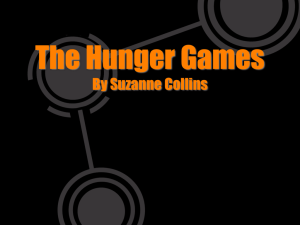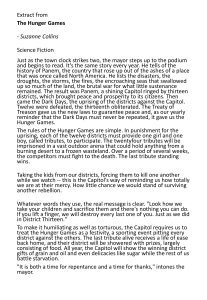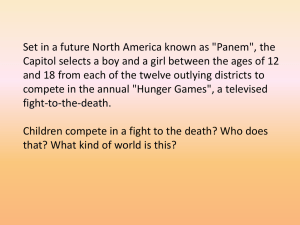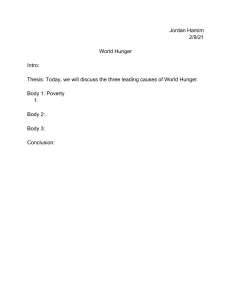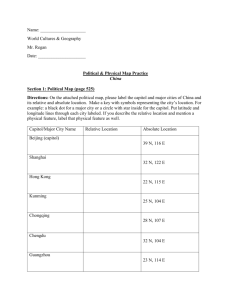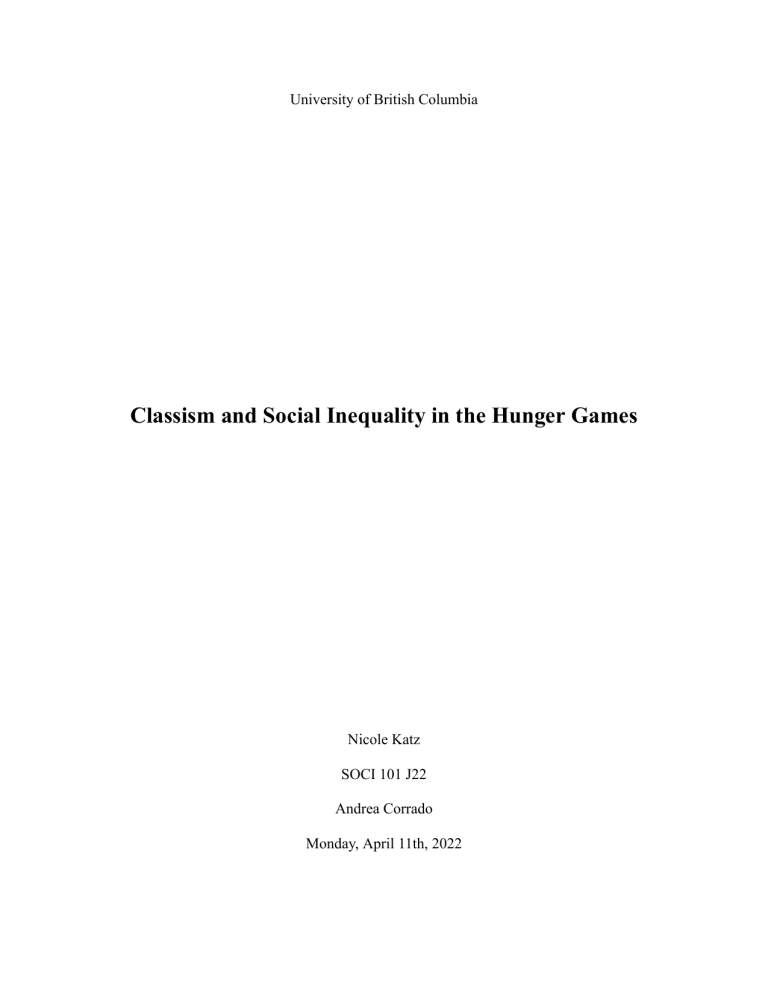
University of British Columbia Classism and Social Inequality in the Hunger Games Nicole Katz SOCI 101 J22 Andrea Corrado Monday, April 11th, 2022 Katz 1 Nicole Katz 12195202 SOCI 101 J22 Monday, April 11th 2022 Introduction Do social classes truly benefit anyone? Social classes have dominated society for centuries, with people of influence and power holding a higher rank in society and being considered a higher value human. However, social classes do not benefit anyone and actually cause more suffering than they do any good. The Hunger Games does an excellent job of portraying this perspective and gives an in-depth view of how a society driven by social classes is bound to fall apart. Societal inequality and classism create an extreme division among the poor and the elite in the society of Panem in the Hunger Games. This inequality leads to both sides feeling unease and creates an unjust and unsafe society. This paper will look at the history of classism before deep-diving into the analysis of specific dialogue, lighting, angles and other factors found throughout the Hunger Games film to determine how classism and societal inequality tear a society apart. Literature Review Social classes have influenced society for thousands of years. Social classes refer to the structure of society where those with influence and power hold a higher class in society, while those who do not hold authority or have wealth are part of the lower Katz 2 classes. This structure results in higher classes being subject to more privileges and living a better quality of life. Meanwhile, lower social classes do not have this privilege and often have to work harder to receive even a fraction of the benefits that higher social classes may receive. Some societal structures that include social classes even withhold human rights, like food, shelter and clean water from lower classes. This social structure is incredibly corrupt and results in many fractures within a stable foundation for a society. When we reflect on ancient Egypt and the structure of society then, we see that the social classes and society were split into multiple categories, with the Pharaoh at the top and considered elite and slaves at the bottom who were considered to be disposable (University College London, 2003). This structure of castes was incredibly corrupt and caused many issues in ancient Egyptian society. This information is useful to keep in mind when analyzing classism as it gives a more well-rounded perspective and allows some history on the subject. It also shows that classism has taken place in society as far as history is recorded. Furthermore, if we jump forward a couple of hundred years to analyze Roman society, it is seen that classism is ever-present in this ancient society as well. Rome was divided into two classes, the plebeians and the patricians. The lower-class plebeians were denied many rights and freedoms that were reserved for the patricians. This inequality caused much social turmoil (Knowlton, 1911). Finally if we analyze social classes in American society from 1980 to 2010 there is proof that lower social classes are linked to income disparity (Wodtke, 2016). Reflecting on the past of conflict between social classes allows for a good foundation when analyzing the meaning behind the social classes that are represented throughout the Hunger Games film. Katz 3 Through analysis of history and other publications on classes, it can be determined that manufactured classes only result in public oppression and societal unease among all classes. One reason for why classes pose such an issue is that during catastrophic events those of lower classes are more negatively impacted by the outcomes than those of a higher class. This is linked to social class risk and therefore “‘class’ is too soft a category to capture the explosiveness of social inequality in world risk society” (Beck, 2013). Furthermore, in societies with higher classism and conflict between groups, there is usually bad governance which leads to higher amounts of civil wars (Walter, 2015). Both of these literatures support the fact that societies divided by classism are unequal and pose many issues that will not allow a society to be cohesive. Data and Methods For methodology I chose to note down all relevant themes that related to the division between the poor and the elite in the society of Panem. I did this by noting down timestamps where specific scenes portrayed this division. I also noted down timestamps when specific angles, lighting or scenery were used to show the division among the society of Panem. An example of when I used a timestamp for a specific scene that showed this division is the scene where Katniss shoots an arrow towards a table of elites who are watching her practice. They are completely unaware of her and almost do not even think of the contestants as real people. This is due to the fact that they are so divided from the rest of their society that they dismiss the lives of those who are not a part of the elite. In fact most of the elite refuse to recognize the suffering and trauma that is experienced from contestants and their families due to the Hunger Games. The capitol Katz 4 truly sees the poor as a source of entertainment and not as living, thinking humans. Therefore, when Katniss breaks this barrier between the elite and the poor, for a moment the bubble they have built around themselves bursts and they realize that they are actually not untouchable. I found this scene incredibly thought provoking and really shows how divided the elite from the capitol are from the rest of Panem. Another form of methodology I used was noting down parts of the script that I found impactful. I did this simply by jotting down quotes, when specific speech was used that furthered my research. Results The Hunger Games is a film that shows the struggle of social classes in the incredibly unequal society of Panem. In Panem, the society is split among the elite who live in the Capitol, and the rest of Panem is split into 12 districts of the working class. The elite lives in extreme wealth, with excess finery, decadent food and a safe city to live in among one another. Meanwhile, the 12 districts are on the opposite side of the spectrum, with many inhabitants of the poorer districts not having access to food, proper shelter or clean water. This was reflected at the beginning of the film when a glimpse of the living conditions of district 12 is shown. It is seen how simply district twelve lives, with tiny broken-down houses and many of the inhabitants looking dirty and dishevelled (3:00-3:16). However, in scenes with the Capitol’s elite, we usually see them dining on extravagant meals, like the game makers who were dining together on a lavish roasted pig in the room above the training arena (43:33). These extremely polar opposite experiences of living allow viewers to see how divided and unethical a classist society is. Katz 5 Within the Hunger Games, we see the division of the districts where the lower numbered districts, like District 1, who provide the Capitol with their jewelry and luxury items, live in a bit more comfort than the higher number districts, like District 12, which is the mining district but does not offer much to the Capitol. This difference in living conditions is portrayed when the Hunger Games tributes are introduced (30:44). The lower districts also tend to be Capitol favourites, resulting in them receiving more sponsors/advantages throughout the games. This difference in living conditions among the districts is a tactical move of the Capitol, as it helps in pitting the districts against one another, which stops them from banding together as a whole to take down the overall enemy, the Capitol’s elite. Another way that the Capitol attempts to control the districts is through the Hunger Games itself, which is a punishment for the districts for the rebellion they had to overthrow the Capitol 74 years prior. This is explained in the opening scene of the movie, where text on the screen reads, “In penance for their uprising, each district shall offer up a male and a female between the ages of 12 and 18 at a public ‘Reopening.’” (Ross, 2012, 1:00). The Capitol also uses its strong army force, who are quite aggressive with the districts (11:18) and other fear tactics like propaganda (12:40) to keep the districts in check. All of these tactics are used by the Capitol in fear of losing control over the districts. The struggle between the classes is not a new idea within any society. However, the Hunger Games tries to use exaggeration, metaphors and dramatic scenery to drill into the heads of viewers how corrupt a classist society may be. This is done mainly through the plotline in which they have the districts compete in a deathmatch annually as a way to repent for their rebellion. The annual Hunger Games indeed shows how disconnected the Katz 6 Capitol is from the rest of Panem. They do not see the members of the districts as human beings, or at least as human beings worthy of the right to live. The elite truly finds the bloodshed of the district members in a brutal game to be entertaining and enjoyable. The mindset of the elite is an extreme exaggeration of how social classes are structured but does take an interesting perspective to light. In society, social class truly does equate to the value of life. In North America, we are lucky enough that those of lower social classes usually are not withheld rights and have access to safe shelter and food through social programs. In BC alone, we have social programs for housing, food and financial support (Province of British Columbia, 2021). However, we still live in a society where homeless people are almost not recognized as human beings and are looked down upon by those of higher social classes. This results in the dehumanization of homeless people, and though the intent may not be so, they do lose many societal privileges like the freedom to get a job, as someone of a higher social class will almost always be considered first. Though social classes in current society look quite different than those in the movie The Hunger Games, it is still important to compare the two as the film is a twisted reflection of our own society. Though the members of the Capitol like to believe that the structure of their society is beneficial to them and they get to live in peace while the districts work to supply them with all their resources, the social system they live in truly does not benefit anyone. This is because the gap between the elite of the Capitol and the districts is too large. The Capitol asks for too much from the districts and may maintain them using fear tactics. However, this will not work forever. The foundation of their society is broken and unjust and can quickly come crashing down at any moment. Even the Capitol’s elite Katz 7 recognizes this and, in fact, live in fear of an uprising from the districts. This is why no one truly benefits in their classist society because they all live in fear at the end of the day. With the districts living in fear of the Capitol’s brutality and punishment and the Capitol living in fear of an uprising of the districts. However, the Capitol is in more danger in this scenario because they truly have so much more to lose. The districts are already a mockery and treated as less than human. Therefore, once they reach their final pushing points, they have no issues choosing to rebel as what is the point of being alive if you have truly nothing. All that the district members have is each other and their families, but when they recognize the inequity they live in, it is almost a joke to continue living in such poor conditions. This is what eventually will lead to the uprising, as once the members of the districts get over their fear of being reprimanded, they don’t have much to lose. Furthermore, power in numbers is something the districts hold over the Capitol as they are truly outnumbered. This is why the Capitol will never be fulfilled or be able to enjoy the structure of their society, as they too will always live in fear of being overthrown. Finally, a possible structure of society can be hypothesized that could solve issues for both sides and result in a more equitable society for all in Panem. There are countless forms of societies that could work to solve this issue. However, the best would most likely be to still have some social classes with way less differentiation and less power distribution. Ruling out social classes completely would probably not allow for a more equitable society and would likely cause issues on the opposite side of the spectrum. For example, with simply no social classes at all and everyone being regarded at the same level, there is a loss of ambition, and people may feel as though they are not their unique Katz 8 individuals. Everything in moderation, therefore toning down the societal classes and allowing people to be rewarded for their hard work and still having somewhat of a social ladder to climb, which will result in members of society remaining ambitious. However, with less differentiation between the classes, there will be less dehumanization of the lower classes and allow for the classes to live in peace among one another. Social classes that are naturally formed and an undercurrent to society can actually be quite beneficial and allow for much societal growth and allow society to be more unified overall as a diverse society that works together. In contrast, social classes that are manufactured and maintained, like the numbered districts, will not have this effect and will not allow for growth among individuals in society. Conclusion In conclusion, social classes have been ever-present in society for thousands of years. The Hunger Games film does an excellent job at showing the dangers of social classes when taken too far. However, it is still essential to consider the benefits of natural social classes, as a society without any differentiation does not allow for individuality. Furthermore, The Hunger Games shows that no one, especially the elite, will benefit from a fully differentiated society into social classes because the elite end up always living in fear. Classism can lead to social inequality and tear a society apart, but natural classes may allow for societal growth. Therefore, it can be concluded through analysis of the film The Hunger Games and the history of social classes in our society that everything in moderation is an excellent way to solve this social inequality. It allows for a society with social classes that may still function and thrive. Katz 9 References Beck, U. (2013). “Why ‘class’ is too soft a category to capture the explosiveness of social inequality at the beginning of the twenty-first century.” Wiley Online Library. Retrieved April 10, 2022. (https://onlinelibrary.wiley.com/doi/full/10.1111/1468-4446.12005) Knowlton, Daniel C. 1911. "Struggle between Plebeians and Patricians." History Teacher's Magazine 2(6):128 (https://www.proquest.com/scholarly-journals/struggle-between-plebeians-patricia ns/docview/1296482647/se-2?accountid=14656). Province of British Columbia. (2021, December 9). “Homelessness.” Province of British Columbia. Retrieved Apr. 6, 2022. (https://www2.gov.bc.ca/gov/content/housing-tenancy/affordable-and-social-housi ng/homelessness) Ross, G. (2012). The Hunger Games. Lionsgate. University College London. 2003. “Social classes in ancient Egypt” Retrieved Apr. 4, 2022. (https://www.ucl.ac.uk/museums-static/digitalegypt/social/index.html) Walter, B. F. (2015). “Why bad governance leads to repeat Civil War.” JSTOR. Retrieved April 10, 2022. (https://www.jstor.org/stable/pdf/24546339.pdf?addFooter=false) Wodtke, G. T. (2016). Social Class and Income Inequality in the United States: Ownership, Authority, and Personal Income Distribution from 1980 to 2010. The University of Chicago Press Journals. Retrieved April 2, 2022. (https://www-journals-uchicago-edu.eu1.proxy.openathens.net/doi/full/10.1086/7 14259) Katz 10 Appendix The Hunger Games is a film that takes place in an alternate reality of North America. In this society, Panem, the Capitol which contains society’s elite, maintains control over the rest of Panem, which is composed of 12 districts. They do so through an annual nationally televised event called the Hunger Games. Within this event a female and male that were randomly selected as a tribute from each of the 12 districts must compete against one another in a deathmatch for the title of victor. The film follows Katniss Everdeen, a member of district 12 after she volunteers to take her sister’s place in the Hunger Games.

